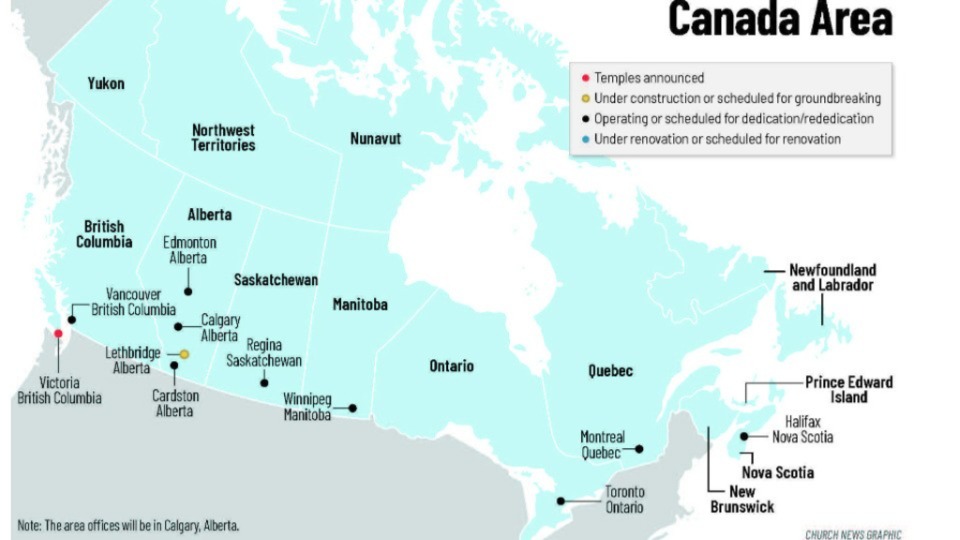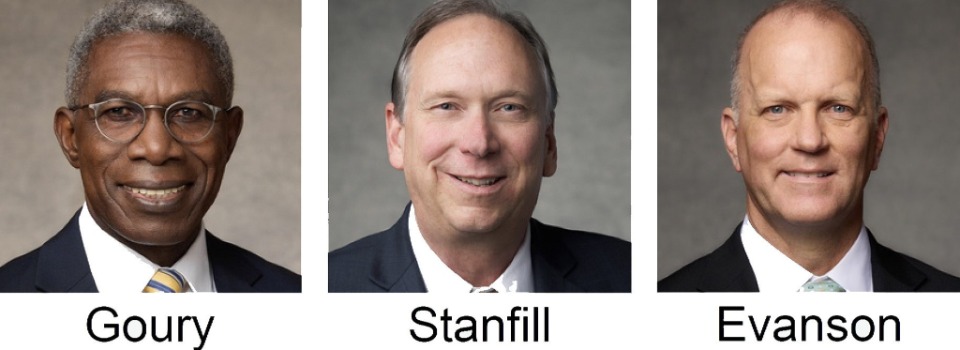
This story appears here courtesy of TheChurchNews.com. It is not for use by other media.
By Lynnette McConkie,Church News
What began with early missionaries and a few printed pages of the Book of Mormon has grown into a lasting legacy of faith across Canada. Now, for the first time, all provinces and territories are united under the newly created Canada Area.
Effective August 1, all 10 provinces and three territories now make up the newly designated Canada Area for The Church of Jesus Christ of Latter-day Saints, the Church’s 24th geographically defined area worldwide. Previously, provinces and territories were divided among three North America areas — Central, Northeast and West.
The First Presidency announced the creation of this new area “to better provide leadership and support for all Church members in Canada.”
Three General Authority Seventies have been assigned to lead the Canada Area. Elder Vern P. Stanfill will serve as president, with Elder D. Martin Goury as First Counselor and Elder James E. Evanson as Second Counselor. The Canada Area office headquarters is located in Calgary, Alberta, with a smaller office in Toronto, Ontario.
 DOWNLOAD
DOWNLOADHistory of the Church in Canada
The history of The Church of Jesus Christ of Latter-day Saints in Canada dates back to the beginning days of the Restoration.
In 1829, even before the Book of Mormon was fully printed, a preacher named Solomon Chamberlin visited the Smith family in New York. Believing in the Restoration of the gospel, he was eager to share it with others. With permission, Chamberlin took 64 of the first printed pages of the Book of Mormon and headed to Canada, where he told people what he had learned, even though the Church hadn’t officially been organized yet.
Canadian heritage in Latter-day Saint Leadership
In addition to John Taylor, four other presidents of the Church were direct descendants of early Canadian Latter-day Saint converts:
-
Joseph F. Smith, sixth Church president, was the son of Toronto convert Mary Fielding.
-
Joseph Fielding Smith, 10th president of the Church, Joseph F. Smith’s son was Mary’ Fielding’s grandson.
-
Harold B. Lee, 11th Church president, was the great-grandson of Augustus Lucius Bingham, who learned of the restored Church in Leeds County, Upper Canada, in the 1830s.
-
Gordon B. Hinckley, 15th president of the Church, was the grandson of Ira Nathaniel Hinckley, who first heard the gospel in 1836 in Leeds County, Upper Canada.
Just a few months after the Church was officially founded in 1830, early Church leaders were sent to preach the restored gospel in Canada.
In 1836, during his mission in Upper Canada, Parley P. Pratt preached to a group of Christians searching for true doctrine, including John Taylor and his wife, Leonora Cannon Taylor. They studied Pratt’s message and were baptized. John Taylor was ordained an apostle in 1838 and would become the third President of the Church years later.
Membership in the region grew significantly, and by 1850, around 2,500 Canadians joined the Church. However, starting in 1847, many of these new Canadian converts left their homes and traveled to the western United States. In all, about 2,000 of the early Canadian members joined the large migration that helped build the early Church communities in the western United States.
Missionary work continued in Canada until September 1857, when the missionaries were recalled and the formal work there was temporarily discontinued during the tensions of the Utah War.
In 1886, President John Taylor advised Charles Ora Card to lead a group of Latter-day Saints from Logan, Utah — fleeing the restrictions of the 1882 Edmunds Act placed on their practice of plural marriage — to settle in southern Alberta, Canada. They established Lee’s Creek (later called Cardston) and within about a year built a meetinghouse for their congregation, which was recognized as the Card Ward in 1888.
Just seven years later, the Cardston Alberta Stake was organized on June 8, 1895, becoming the first stake outside of the United States.
Formal missionary work in Canada was recommenced in 1893 when the Eastern States Mission began intermittently sending missionaries there. Work was slow at first, and more than a decade passed before the Church saw its first Canada baptism in 1904. Although more people began joining the Church, many of the new members moved to Utah, and Church units in Canada struggled to survive with such small numbers.
The establishment of the Eastern Canada Mission in April 1919 saw an uptick in the growth of the Church in the region. Headquartered in Toronto, the mission oversaw preaching activity in Ontario, Manitoba, Quebec, New Brunswick, Prince Edward Island, Nova Scotia, and Newfoundland and Labrador provinces.
Meanwhile, on August 26, 1923, Saints in the Cardston area gathered as Church President Heber J. Grant dedicated their first temple outside the United States — the Alberta Temple, now called the Cardston Alberta Temple.
In July 1941, a second mission was added; the Western Canadian Mission was organized and eventually oversaw preaching throughout Alberta, Saskatchewan, British Columbia, the Yukon Territory and the Northwest Territories.
Since that time, membership has grown to more than 205,000 in 502 congregations, and eight additional houses of the Lord have been dedicated across the Canada Area: the Toronto Ontario Temple (in 1990), the Halifax Nova Scotia Temple (1999), the Regina Saskatchewan Temple (1999), the Edmonton Alberta Temple (1999), the Montreal Quebec Temple (2000), the Vancouver British Columbia Temple (2010), the Calgary Alberta Temple (2012) and the Winnipeg Manitoba Temple (2021). Two more temples are in the construction phase or have been announced to be built: the Lethbridge Alberta Temple (groundbreaking in 2025) and the Victoria British Columbia Temple (announced in 2024).